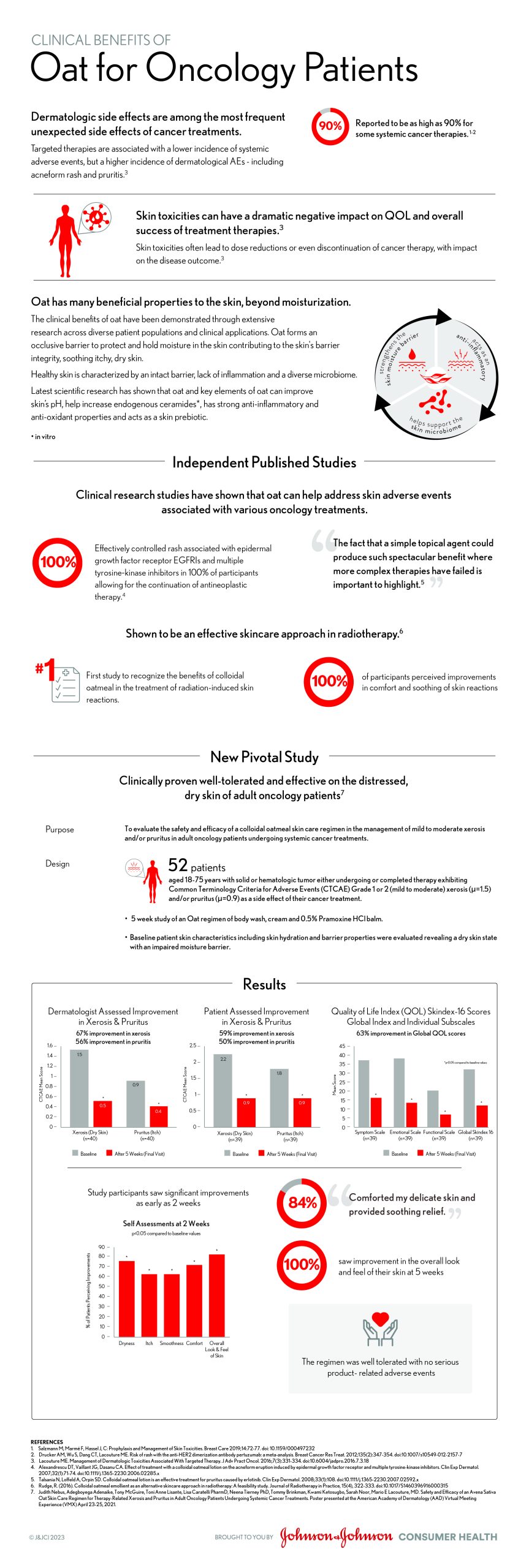Dermatologic side effects are among the most frequent unexpected side effects of cancer treatments.1,2 Targeted therapies are associated with a lower incidence of systemic adverse events, but a higher incidence of dermatological AEs – including acneiform rash and pruritus.3
Skin toxicities can have a dramatic negative impact on QOL and overall success of treatment therapies.3
Skin toxicities often lead to dose reductions or even discontinuation of cancer therapy, with impact on the disease outcome.3
Oat has many beneficial properties to the skin, beyond moisturization.
The clinical benefits of oat have been demonstrated through extensive research across diverse patient populations and clinical applications. Oat forms an occlusive barrier to protect and hold moisture in the skin contributing to the skin’s barrier integrity, soothing itchy, dry skin.
Healthy skin is characterized by an intact barrier, lack of inflammation and a diverse microbiome. Latest scientific research has shown that oat and key elements of oat can improve skin’s pH, help increase endogenous ceramides*, has strong anti-inflammatory and anti-oxidant properties and acts as a skin prebiotic.
Clinical research studies have shown that oat can help address skin adverse events associated with various oncology treatments.
-
- Effectively controlled rash associated with epidermal growth factor receptor EGFRIs and multiple tyrosine kinase inhibitors in 100% of participants allowing for the continuation of antineoplastic therapy.4
- The fact that a simple topical agent could produce such spectacular benefit where more complex therapies have failed is important to highlight.5
- Shown to be an effective skincare approach in radiotherapy.6
New Pivotal Study
Clinically proven well-tolerated and effective on the distressed, dry skin of adult oncology patients7
Purpose: To evaluate the safety and efficacy of a colloidal oatmeal skin care regimen in the management of mild to moderate xerosis and/or pruritus in adult oncology patients undergoing systemic cancer treatments.
Design: 52 patients aged 18-75 years with solid or hematologic tumor either undergoing or completed therapy exhibiting Common Terminology Criteria for Adverse Events (CTCAE) Grade 1 or 2 (mild to moderate) xerosis (μ=1.5) and/or pruritus (μ=0.9) as a side effect of their cancer treatment.
Results:
Dermatologist Assessed Improvement in Xerosis & Pruritus
-
- 67% improvement in xerosis
- 56% improvement in pruritus
Patient Assessed Improvement in Xerosis & Pruritus
-
- 59% improvement in xerosis
- 50% improvement in pruritus
Quality of Life Index (QOL) Skindex-16 Scores Global Index and Individual Subscales
-
- 63% improvement in Global QOL scores
Study participants saw significant improvements as early as 2 weeks
-
- 84% Comforted my delicate skin and provided soothing relief
- 100% Saw improvement in the overall look and feel of their skin at 5 weeks
The regimen was well tolerated with no serious product-related adverse events
Click on the image to enlarge and/or download today’s infographic
The scientists for Aveeno® have also provided a patient education sheet, “Caring for Your Skin Through Cancer Treatment” which can be downloaded here.
REFERENCES
-
- Salzmann M, Marmé F, Hassel J, C: Prophylaxis and Management of Skin Toxicities. Breast Care 2019;14:72-77. doi: 10.1159/000497232
- Drucker AM, Wu S, Dang CT, Lacouture ME. Risk of rash with the anti-HER2 dimerization antibody pertuzumab: a meta-analysis. Breast Cancer Res Treat. 2012;135(2):347-354. doi:10.1007/s10549-012-2157-7
- Lacouture ME. Management of Dermatologic Toxicities Associated With Targeted Therapy. J Adv Pract Oncol. 2016;7(3):331-334. doi:10.6004/jadpro.2016.7.3.18
- Alexandrescu DT, Vaillant JG, Dasanu CA. Effect of treatment with a colloidal oatmeal lotion on the acneform eruption induced by epidermal growth factor receptor and multiple tyrosine-kinase inhibitors. Clin Exp Dermatol.2007;32(1):71-74. doi:10.1111/j.1365-2230.2006.02285.x
- Talsania N, Loffeld A, Orpin SD. Colloidal oatmeal lotion is an effective treatment for pruritus caused by erlotinib. Clin Exp Dermatol. 2008;33(1):108. doi:10.1111/j.1365-2230.2007.02592.x
- Rudge, R. (2016). Colloidal oatmeal emollient as an alternative skincare approach in radiotherapy: A feasibility study. Journal of Radiotherapy in Practice, 15(4), 322-333. doi:10.1017/S1460396916000315
- Judith Nebus, Adegboyega Adenaike, Tony McGuire, Toni Anne Lisante, Lisa Caratelli PharmD, Neena Tierney PhD, Tommy Brinkman, Kwami Ketosugbo, Sarah Noor, Mario E Lacouture, MD. Safety and Efficacy of an Avena Sativa Oat Skin Care Regimen for Therapy-Related Xerosis and Pruritus in Adult Oncology Patients Undergoing Systemic Cancer Treatments. Poster presented at the American Academy of Dermatology (AAD) Virtual Meeting Experience (VMX) April 23-25, 2021.Experience (VMX) April 23-25, 2021.
Did you enjoy this Skincare Monday article? You can find more here.


